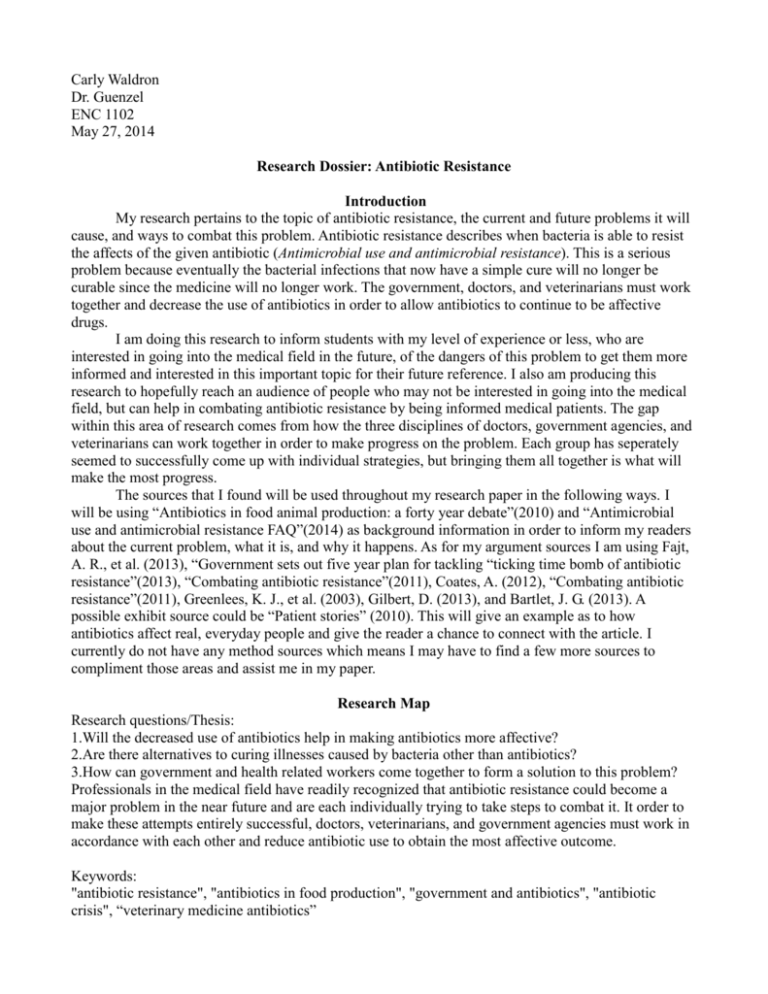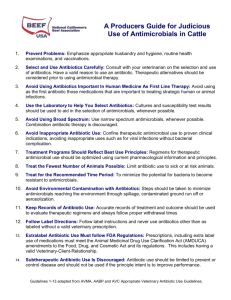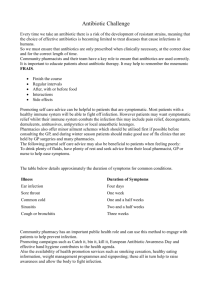Research Dossier
advertisement

Carly Waldron Dr. Guenzel ENC 1102 May 27, 2014 Research Dossier: Antibiotic Resistance Introduction My research pertains to the topic of antibiotic resistance, the current and future problems it will cause, and ways to combat this problem. Antibiotic resistance describes when bacteria is able to resist the affects of the given antibiotic (Antimicrobial use and antimicrobial resistance). This is a serious problem because eventually the bacterial infections that now have a simple cure will no longer be curable since the medicine will no longer work. The government, doctors, and veterinarians must work together and decrease the use of antibiotics in order to allow antibiotics to continue to be affective drugs. I am doing this research to inform students with my level of experience or less, who are interested in going into the medical field in the future, of the dangers of this problem to get them more informed and interested in this important topic for their future reference. I also am producing this research to hopefully reach an audience of people who may not be interested in going into the medical field, but can help in combating antibiotic resistance by being informed medical patients. The gap within this area of research comes from how the three disciplines of doctors, government agencies, and veterinarians can work together in order to make progress on the problem. Each group has seperately seemed to successfully come up with individual strategies, but bringing them all together is what will make the most progress. The sources that I found will be used throughout my research paper in the following ways. I will be using “Antibiotics in food animal production: a forty year debate”(2010) and “Antimicrobial use and antimicrobial resistance FAQ”(2014) as background information in order to inform my readers about the current problem, what it is, and why it happens. As for my argument sources I am using Fajt, A. R., et al. (2013), “Government sets out five year plan for tackling “ticking time bomb of antibiotic resistance”(2013), “Combating antibiotic resistance”(2011), Coates, A. (2012), “Combating antibiotic resistance”(2011), Greenlees, K. J., et al. (2003), Gilbert, D. (2013), and Bartlet, J. G. (2013). A possible exhibit source could be “Patient stories” (2010). This will give an example as to how antibiotics affect real, everyday people and give the reader a chance to connect with the article. I currently do not have any method sources which means I may have to find a few more sources to compliment those areas and assist me in my paper. Research Map Research questions/Thesis: 1.Will the decreased use of antibiotics help in making antibiotics more affective? 2.Are there alternatives to curing illnesses caused by bacteria other than antibiotics? 3.How can government and health related workers come together to form a solution to this problem? Professionals in the medical field have readily recognized that antibiotic resistance could become a major problem in the near future and are each individually trying to take steps to combat it. It order to make these attempts entirely successful, doctors, veterinarians, and government agencies must work in accordance with each other and reduce antibiotic use to obtain the most affective outcome. Keywords: "antibiotic resistance", "antibiotics in food production", "government and antibiotics", "antibiotic crisis", “veterinary medicine antibiotics” Research types: Library research I currently have 4 sources that have come from library research. These sources fit best within the argument area of my paper. People specialized in the field and scholarly articles will be very useful sources to explain what needs to be done to fix antibiotic resistance. Internet Research I currently have 6 sources from internet research. They are especially helpful for background information and method. The majority of these sources come from established organizations who have people in the specified field running them. Field Research I currently have no field research. Although I think it would be a very helpful addition, because of time constraints it will be very difficult to obtain. If at some point I can get some type of field research it will be used to support my argument. Date Layout: Digital Paper Trail: 5/22 Workshop Draft Research Dossier: 5/28 Final Research Dossier: 5/29 Fort Lauderdale Baby Shower: 5/30-6/1 Workshop Draft Rhetorical Analysis: 6/4 Final Rhetorical Analysis: 6/5 Research Pitch: 6/9 Draft 1: 6/11 Draft 2: 6/16 Final Paper: 6/17 TED Talk, E-portfolio: 6/19 Research 5/20-6/9 F2f meeting 5/26 Peer review F2f meeting 6/3 F2f meeting 6/10 Peer review Peer review Annotated Bibliography Antibiotics in food animal production: a forty year debate. (2010, December 15). Alliance for the Prudent Use of Antibiotics, 28(2). Retrieved from http://www.tufts.edu/med/apua/news/newsletter_33_3555326098.pdf This article discusses the affects of antibiotics in food animals and how it contributes to antibiotic resistance. The author tries to persuade the audience to terminate the use of antibiotics all together in food animals in order to increase drug effectiveness in humans. The article comes from an organization within Tufts University, an accredited university and veterinary school. Although the article does seem to be very opinionated and slightly biased the author does use ample evidence to back the statements. Antimicrobial use and antimicrobial resistance FAQ. (2014). American Veterinary Medical Association. Retrieved from https://www.avma.org/KB/Resources/FAQs/Pages/Antimicrobial-Use-andAntimicrobial-Resistance-FAQs.aspx This article describes the basics behind antibiotic resistance such as what antibiotics are, what they treat, and why/how antibiotic resistance happens. The article's purpose seems more to inform the general public so they can make better decisions rather than persuade. The American Veterinary Medical Association is an organization run by licenced veterinarians. It is a very factual writing and does seem to take any bias, just includes facts. Bartlet, J. G., et al. (2013). Seven ways to preserve the miracle of antibiotics. Clinical Infectious Diseases: An Official Publication of the Infectious Diseases Society of America, 56(10). The authors of this article acknowledge the problem of antibiotic resistance and offer methods of combating it that include, but are not limited to, collecting data, reducing antibiotic use, and new antibiotic developments. The article is informing the audience of the multiple possibilities associated with pushing against antibiotic resistance. The authors are listed as affiliated with Johns Hopkins University, Department of Medical Education of Providence Portland Medical Center, and Liu Vaccine Center. The authors statements are unbiased and backed with numerous evidence such as quotes, charts, and tables. Coates, A. (2012). Antibiotic resistance. Handbook of Experimental Pharmacology. Heidelberg: Springer. This article goes into a more in-depth description of the types of microbial that are on the rise of becoming drug resistant, focusing on bacteria, fungi and yeast, and how these will help lead to the development of new agents to fight the drug-resistant microbial. The author works within the Department of Laboratory Medicine and Pathology. The purpose of the article seems to persuade the audience that developing new agents is the solution to overcoming antimicrobial resistance. It is slightly biased toward certain microbial, however the author does state that the viruses that would otherwise be included are outside the scope of the article. Combating antibiotic resistance. (2011, November 15). U.S Food and Drug Administration. Retreived from http://www.fda.gov/forconsumers/consumerupdates/ucm092810.htm#top This article gives a brief description of what antibiotic resistance is, how it happens and how patients with an illness can better determine whether they need an antibiotic or if it is a viral infection. It also goes into brief detail in what the Food and Drug Administration is doing to help prevent further antibiotic resistance. The Food and Drug Administration is a trusted U.S government organization that protects the public. The article's bias was towards patients and doctors, and the different things they can do to make sure antibiotic resistance does not worsen. Fajt, V. R., et al. (2013). Survey of instructors teaching about antimicrobial resistance in the veterinary professional curriculum in the United States. Journal of Veterinary Medical Education, 40(1), pp. 35-44. This article is a study done to determine the current forms of teaching toward veterinary students regarding antibiotic resistance. The purpose of the article seemed to be to inform the audience of different methods of teaching antibiotic resistance in the veterinary field. The author is associated with the College of Veterinary Medicine at Texas A&M University. The article is supported with large amounts of evidence gathered from their study, and it does not seem to have a bias, just facts and conclusions from their study. Gilbert, D. (2013, December 29). Fight fear with science. The New York Times. Retrieved from http://www.nytimes.com/roomfordebate/2013/12/29/avoiding-a-time-when-bacteria-can-nolonger-be-stopped/overcome-irrational-fears-of-infection-with-proper-use-of-antibiotics This article talks about the problems and reasoning behind why doctors prescribe patients antibiotics when they are not necessarily needed. The author uses a claim of fear on the physicians part to explain this happening. The author is chief of infectious diseases at Providence Portland Medical Center. He seems to use many personal beliefs within his reason and uses phrases such as, “I believe..” without having the necessary support to back up his beliefs. He does include some statistical information within his article, however. His bias seems to come from his own personal opinions rather than hard facts or research. Government sets out five year plan for tackling “ticking time bomb” of antibiotic resistance. (2013). British Medical Journal. Retrieved from http://www.bmj.com/content/347/bmj.f5560view =long&pmid=24026518 This article outlines the 5 year plan that the government is attempting to implement in order to decrease antibiotic resistance. The purpose is to inform the audience about the current plans of the government. The author, however, is not a specialists in the medical field, and rather is a journalist writing about the plan. There does not seem to be any bias, and the author uses multiple pieces of evidence cited within her article. Greenlees, K. J., et al. (2003). Animal drug human food safety toxicology and antimicrobial resistancethe square peg. International Journal of Toxicology, 22(2). This article discusses the problems behind drugs given to food animals, how it affects humans, and how it contributes to antibiotic resistance. The purpose of this paper is to persuade the audience to act on how drugs are used within food animals and to implement interest on finding what level of drugs is acceptable in these animals without having an affect on humans. The author is an employee under the FDA Center for Veterinary Medicine. There does not seem to be any bias within the article. Patient Stories. (2010, October). Infectious Disease Society of America. Retrieved from http://www.idsociety.org/Patient_Stories/ This webpage contains numerous stories about real people who suffered from an antibiotic resistant bacteria and died because the drugs were not effective. The purpose of these articles seem to be to persuade the general public to take more interest in the matter so future deaths do not happen. The articles are within the Infectious Disease Society of America's webpage, whose organization is run by practicing doctors. The article is biased towards victims of antibiotic resistance and fails to mention ways that this problem can be fixed.






